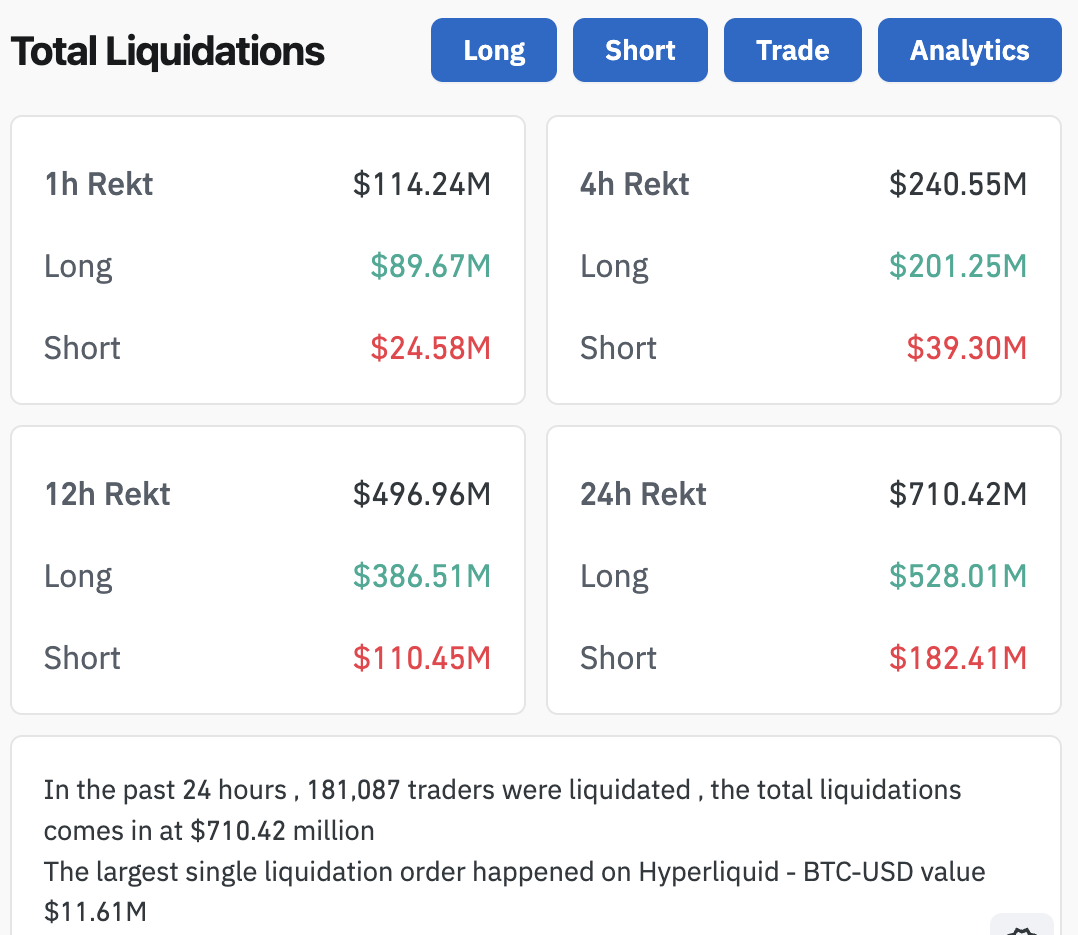$100 Million Lost in One Hour: Bitcoin Drops Spark Rampaging Liquidations
Bitcoin’s $4,000 drop sparked $700 million in liquidations, proving retail traders still wield power despite institutional dominance. Analysts now eye how these dual forces will shape BTC’s next move.
Retail Bitcoin traders made themselves heard today, causing $700 million in crypto liquidations. The price of BTC fell by around $4,000 as on-chain activity spiked, even though institutions kept buying.
Whether or not BTC keeps dropping or recovers soon, we need to pay attention to these dynamics. Corporate liquidity is very influential in the market, but it’s not the final arbiter of price.
Bitcoin Causes Surprise Liquidations
When Bitcoin hit two successive all-time highs earlier this week, it caused a little consternation in the community. This took place despite a lack of retail activity, with institutional investors powering the growth.
Crucially, these corporations continued making huge purchases while BTC’s value was inflated.
In other words, there have been fears that these inflows could profoundly alter market cycles. Arthur Hayes even proclaimed that the four-year cycle was dead and that global institutional liquidity would determine token prices now.
Today, however, these concerns seem less serious. Bitcoin fell around $4,000 in the last 24 hours, spawning a frenzy of crypto liquidations. Over $114 million in total short positions were eradicated in one hour:
 Bitcoin Drops Cause Liquidations. Source:
CoinGlass
Bitcoin Drops Cause Liquidations. Source:
CoinGlass
Retail Traders’ Impact
A few key factors suggest that retail Bitcoin traders caused all these liquidations. For one thing, ETF issuers continued buying BTC at elevated rates, and the products are seeing huge inflows. Meanwhile, BTC’s on-chain trading activity has spiked between 4% and 5%, showing that activity is stirring awake.
Analysts have already identified some of the most likely causes for Bitcoin’s retreat to $120,000, which triggered these liquidations. They seem like pretty standard price actions; long-term traders are taking profits, holder accumulation rates sparked low confidence, etc.
Furthermore, there are even signs that BTC could rebound in the near future.
This, too, presents a useful opportunity to gather valuable market data. These new structural forces are very powerful, but they aren’t all-powerful.
Retail activity still spurred a major Bitcoin price dump, causing a cascade of liquidations. What new narratives can help explain this behavior and enable accurate predictions?
Whether Bitcoin keeps going up or down, these questions should be at the forefront of traders’ minds. These institutions are apparently going to keep stockpiling Bitcoin either way.
Disclaimer: The content of this article solely reflects the author's opinion and does not represent the platform in any capacity. This article is not intended to serve as a reference for making investment decisions.
You may also like
Trump’s ACA Subsidy Proposal Weighs Financial Relief Against Concerns Over Fraud in a Delicate Political Balance
- Trump proposes extending ACA subsidies for two years, raising eligibility to 700% FPL and ending zero-premium plans to combat fraud. - The plan faces bipartisan challenges, with Senate voting in mid-December and House Republicans favoring alternative cost-cutting measures. - Analysts warn premium hikes could destabilize ACA markets, risking coverage for 22 million Americans amid partisan gridlock.
Thiel Turns to Major Defensive Tech Firms Amid Growing Concerns Over AI Bubble
- Peter Thiel's Q3 2025 portfolio reshuffling saw full exit from Nvidia and reduced Tesla holdings , shifting funds to Apple and Microsoft amid AI valuation concerns. - The $166M from sales was partially reinvested into Apple and Microsoft, leaving over $120M in cash reserves, signaling a defensive strategy shift. - Nvidia's 0.33% premarket dip and mixed market reactions highlight institutional sentiment shifts, with analysts debating Thiel's caution versus potential miscalculation. - Thiel's track record

Burnout Epidemic Pushes Companies to Address Wave of 'Revenge Resignations'
- 55% of U.S. workers report burnout, driving "revenge quitting" surge as 72% see reduced efficiency and 71% lower job performance. - Burnout disproportionately impacts Gen Z (66%) and remote workers (61%), linked to workload (50%) and poor team dynamics (50%). - Only 42% of burnt-out employees discuss struggles with managers, with half receiving no meaningful support, risking talent exodus. - Eagle Hill Consulting warns burnout threatens organizational stability, urging leaders to address root causes befo
Solana News Update: In 2025, Investors Focus on Diversifying Rather Than Speculating in Their Crypto Approaches
- Sygnum Bank's 2025 report reveals 57% of investors prioritize crypto for portfolio diversification, surpassing speculative gains as the top motive. - Crypto's low correlation with traditional assets drives its adoption as a strategic hedge against macroeconomic risks, with 70% seeking staking yield inclusion in ETFs. - High-net-worth investors allocate 10%-20% to crypto for wealth preservation, while 150+ U.S. crypto ETF applications highlight growing institutional demand. - Regulatory uncertainty (40% c
